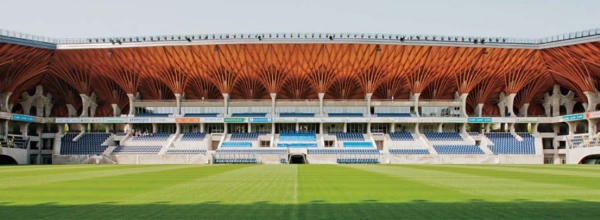Hommage a Puskás
Pancho Arena, Felcsút
Architect: Tamás Dobrosi
Text: Gábor Erhardt
Photos: Tamás Bujnovszky

The building is erected in the garden formerly belonging to the mansion, wedged in a site defined by the lower fields, the mansion and a street with an inclination of 8 metres. As the house is sunk into the ground it has more friendly dimensions when viewed from the mansion, and the service level is accessible easily and barrier-free from the lower side. The proximity of the buildings slightly compromised the design of the upper main facade, thus the designer preferred to use more humane forms for the long main facade – by evoking architectural details of the building completed in the second stage – instead of grand-scale dimensions. Covering the grandstands, the arched veil-like roof is pierced by three towers which result in an architecturally versatile space and spatial wall appearing quite intimate, which is unusual in the case of a stadium, but finely resonates with the micro-environment. The spurs of the roofing reaching down to the ground separate these three types of „traffic” that even so communicate with each other inside the building owing to witty see-throughs between the levels.
The interior of the stadium also functions as a background for the broadcasts and thus features significant powers to create identity as the stadium building is an integral part of the team brand which ranges from inscribed mugs and sport shirts to the visual contents of the B-roll images used in broadcasts. The brand of Felcsút is reinforced by the unique organic forms of the building. All over the world it is typical of stadium architecture to use modern membranous roofing as an engineering structure to cover the grandstands skipping the chance to rely upon the representative potentials of the interior view. In our case as a result of the organic principle of design work a grid-type roof structure grows out from the concrete structure like the foliage from the trunk, which makes the Arena a genuinely unique one of its kind. As an extraordinary designer’s gesture, the structure is made visible from several points to those making a tour of it on the outside: by using see-throughs and piercings it is sort of taken out into the street to make it a public issue also in local scale.
Client: A Felcsúti Utánpótlás Neveléséért Alapítvány
Leading architect: Tamás Dobrosi
Fellow architects: Imre Balázs Arnóczki, Antal Szegedi, Krisztina Törekiné Bakó, László Király, Ferenc Vavrik, Barna Jóföldi, Oszkár Orbán, Lídia Mikus, Olivér Kis-Simon, Tamás Dósa Papp
Interior design: Zsuzsanna Snopper
Structure: László Pongor – Pond Mérnöki Iroda Kft.
Electrical engineering: Zsuzsanna Kovács Lászlóné Homonnay – Inter Ház Tech Bt.
HVAC: László Nagy – NNGáz Kft.






